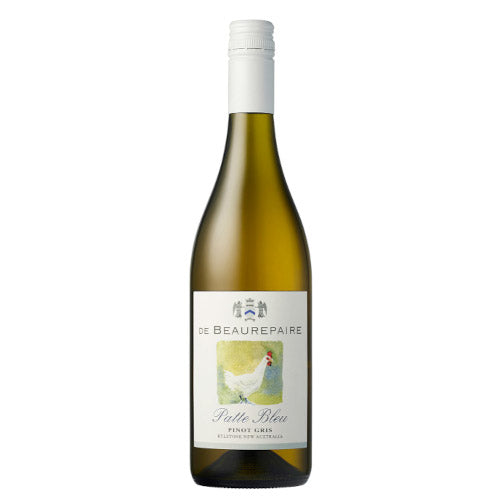2022 'Patte Bleu' Pinot Gris
$40.00
Please select all options.
DESCRIPTION
Our Pinot Gris is not to be confused with the high yielding, high acidity, cheap and cheerful Pinot Grigio school, originating in Veneto and Friuli. Our intention was to produce a mid-slope, Alsatian-style Pinot Gris – a rich, complex, textural aromatic wine – designed to age, match with food and produce a medium bodied wine. We decided to also leave the grapes on the skins to extract additional aromas and flavours, together with a little tannin to give our interpretation of a dry, aromatic mid-slope Alsatian Pinot Gris.
HERITAGE
‘Patte Bleu’ is slang for the blue feet of the chickens from around our family’s hometown in Burgundy – Beaurepaire-en-Bresse. These chickens are appellation controlled and called Poulet de Bresse. They’re famous not just for the quality of their meat which is sought after by many chefs, but also for their red plume, white feathers and blue legs – making them quite literally France’s chicken. Our 700 year old ancestral family home in Bresse, still occupied by the family, lies just east of Beaune – the capital of Burgundy’s wine industry.
TERROIR
The vineyard is located above Rylstone in the Central Ranges GI of NSW (40km southeast of Mudgee, 70km northeast of Bathurst). It was planted in 1998 by Richard & Janet de Beaurepaire, with a mixture of Bordeaux, Rhône, and Burgundy varieties with the intention of selling most of the grapes whilst organically growing wine production. The decision to plant the vineyard at this location over other established winegrowing regions (including family winemaking operations in the Yarra Valley) was due to the similarity of the terroir to Burgundy – the home of the de Beaurepaire family. The vineyard is in a mountain valley, 150 kilometres from the coast in the Great Dividing Range. It is planted on North facing slopes rising from the Cudgegong River to an altitude of 650m. Geologically, the vineyard is planted on an Ordovician-era (450 MY ago) coral reef with shallow sandy and sandy-loam soils on limestone. The limestone was mined nearby until recently by Kandos Cement. The altitude, distance from ocean and poor heat retention of the soil and limestone, creates an inland continental climate as cool as Central Otago in New Zealand and Tasmania in Australia during the growing season with extreme diurnal variation – late Sept/Oct Budburst, Jan/Feb Veraison and March/April Harvest.
VINEYARD
Vintage Conditions: A relatively cool vintage with decent rainfall. Some early frosts reduced yields in early budburst varieties. The summer was relatively cool, with rainfall ensuring very active canopy management to mitigate disease risks. Another great year for acidity.
Harvest (yield): Machine harvested on the evening of 11 March with a baumé of 13 and pH of 3.35. Yield was approximately 3.5 tonnes per hectare (~20 hl/ha). Sourced from A Block (clone D1V7), with an average vine age of 21 years. The soils are very shallow (down to 30cm in spots), predominantly free-flowing sand with a little clay over limestone bedrock with a moderate slope.
VINIFICATION
Crushed and destemmed and then left on skins for 4 hours before being very gently pressed over 5 hours. Pressing was very slow and gentle on the destemmed fruit. Juices from the last pressing were not retained. Fermentation started cool (16 degrees) and was undertaken using native (“wild”) yeasts. Once fermentation was 90% complete it was transferred to stainless-steel tanks. Limited malolactic conversion. Not fined. Vegan.
AGING
Kept on lees in steel tanks for 9 months on lees with limited battonage.
ANALYSIS: pH 3.35, TA 5.5g/l, RS 2g/l
TASTING NOTES
Aromas of pears and peaches, hints of honeysuckle and gingerbread. Fresh citrus and ripe pear with very lightly smoked earthy notes (truffles and funghi) bouquet. Great length and mouthfeel, gentle tannins from the skin contact and dry.
VIN ET GASTRONOMIE
Seared or grilled meaty fish or shellfish served in sauce or cream; Asian wok-fried style vegetables and chicken with a sweet and sour or spicy sauce or Indian curries and dahl. Veal blanquette or Mushroom risotto, terrines and foie gras. Pungent, washed-rind cheeses.
WINE TIPS
Cellaring Potential: 10 years.
Serving Temperature: 8 degrees C / 46 degrees F
VARIETAL MIX: 100% Pinot Gris
ALCOHOL: 13.0%
BOTTLES PRODUCED (CASES): 3,480 (290 cases)
GI: Central Ranges (Rylstone), NSW


